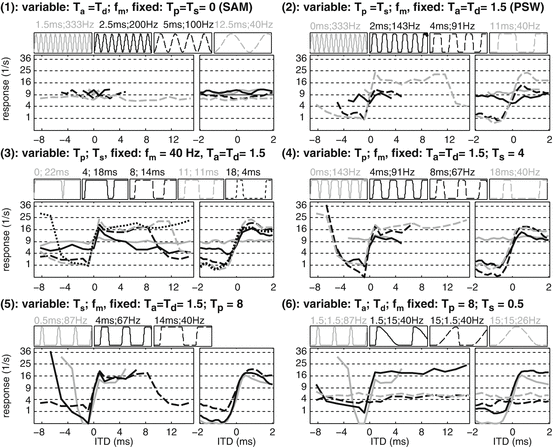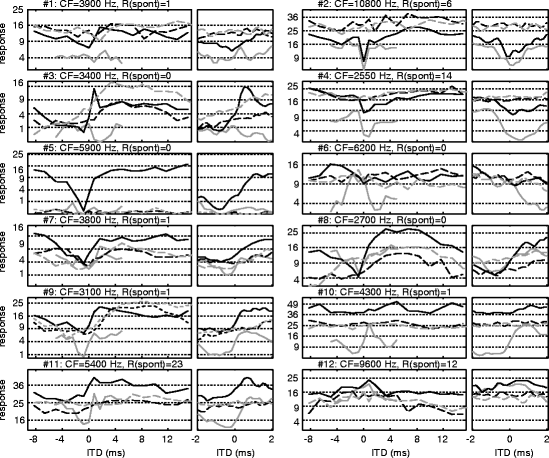Fig. 25.1
Rate-ITD-functions of 17 different envelope shapes for an example neuron with CF = 10,600 Hz and a spontaneous rate of 15 s−1. Conditions are displayed in six groups. Within one group, one segment duration (either T p, T a, T s, or T d) is varied, the other three segment durations and the modulation frequency f m are either fixed or co-dependent. The only exception is group 6 where both T a and T d are varied independently. There is always at least one co-dependent variable because of the relation  . Some envelope shapes are used in several groups. Upper subpanels of each group are the legend illustrating the envelope of the conditions in the line style of the corresponding rate-ITD-function. Numbers over each envelope are the variable parameters given in the same order (segment duration(s) in ms, modulation frequency in Hz). The fixed parameters are included in the title of each group. The main panel shows the rate-ITD-functions over the duration of one modulation period, recorded with an ITD spacing of 1.67 ms or less. The smaller panel on the right shows the central ITD range [−2 ms; +2 ms] recorded with a narrower spacing of 167 μs and plotted after weighted-3-point-averaging. Note that the ordinate is linear for the squared response rate. Explanation for this choice of ordinate is provided in Sect. 3
. Some envelope shapes are used in several groups. Upper subpanels of each group are the legend illustrating the envelope of the conditions in the line style of the corresponding rate-ITD-function. Numbers over each envelope are the variable parameters given in the same order (segment duration(s) in ms, modulation frequency in Hz). The fixed parameters are included in the title of each group. The main panel shows the rate-ITD-functions over the duration of one modulation period, recorded with an ITD spacing of 1.67 ms or less. The smaller panel on the right shows the central ITD range [−2 ms; +2 ms] recorded with a narrower spacing of 167 μs and plotted after weighted-3-point-averaging. Note that the ordinate is linear for the squared response rate. Explanation for this choice of ordinate is provided in Sect. 3
 . Some envelope shapes are used in several groups. Upper subpanels of each group are the legend illustrating the envelope of the conditions in the line style of the corresponding rate-ITD-function. Numbers over each envelope are the variable parameters given in the same order (segment duration(s) in ms, modulation frequency in Hz). The fixed parameters are included in the title of each group. The main panel shows the rate-ITD-functions over the duration of one modulation period, recorded with an ITD spacing of 1.67 ms or less. The smaller panel on the right shows the central ITD range [−2 ms; +2 ms] recorded with a narrower spacing of 167 μs and plotted after weighted-3-point-averaging. Note that the ordinate is linear for the squared response rate. Explanation for this choice of ordinate is provided in Sect. 3
. Some envelope shapes are used in several groups. Upper subpanels of each group are the legend illustrating the envelope of the conditions in the line style of the corresponding rate-ITD-function. Numbers over each envelope are the variable parameters given in the same order (segment duration(s) in ms, modulation frequency in Hz). The fixed parameters are included in the title of each group. The main panel shows the rate-ITD-functions over the duration of one modulation period, recorded with an ITD spacing of 1.67 ms or less. The smaller panel on the right shows the central ITD range [−2 ms; +2 ms] recorded with a narrower spacing of 167 μs and plotted after weighted-3-point-averaging. Note that the ordinate is linear for the squared response rate. Explanation for this choice of ordinate is provided in Sect. 3 For the sinusoidally amplitude modulated (SAM) tones (group 1), this neuron clearly shows ITD tuning for modulation frequencies between 40 and 200 Hz. For pseudo-square-wave (PSW) envelopes (group 2), the rate-ITD-functions are generally steeper than for SAM. For a modulation frequency of 333 Hz, the PSW stimulus is identical to the SAM. If the duty cycle is varied at a constant 40-Hz modulation frequency (group 3), the response R of the neuron increases with a decrease in duty cycle, that is, with an increase in pause duration. The steepness of the rate-ITD-function remains constant in terms of the R 2-linearized ordinate for all but the T p = 0 condition, where almost no tuning is observed. A similar pattern is observed for group 4, where the pause duration was varied with a constant sustain duration (and thus co-varying f m). Here, however, the steepness of the ITD tuning starts to decrease again for long pause durations, once more demonstrating this neuron’s preference for f m > 40 Hz. For group 5, the sustain duration T s was varied with a constant T p = 8 ms, revealing a reduction in tuning steepness when the sustain duration is increased from 0.5 to 4 ms. If the sustain duration is further increased to 14 ms, the steepness stays constant but the overall rate decreases. In the final, but perhaps most critical, group of conditions, the isolated influence of the duration of the attack and the decay flank was investigated. This example neuron shows the steepest tuning if both attack and decay flank are short (short/short condition). Relatively sharp ITD tuning is also observed for the short/long condition, but almost no tuning for the long/short and long/long conditions.
Rate-ITD-functions of a second example neuron are shown in Fig. 25.2. This neuron does not exhibit any ITD tuning for the SAM conditions. For the PSW, however, the rate-ITD-function is very steep around ITD = 0 for conditions with f m < 100 Hz. The same holds for all conditions in groups 3, 4, and 5 as long as the pause duration is at least 4 ms. For group 6, the neuron shows a steep tuning function if the attack duration is short (1.5 ms). For the two conditions with long, shallow attack durations, the neural response is independent of the ITD.


Fig. 25.2
Same format as Fig. 25.1 but for a second example neuron with CF = 6,000 Hz and a spontaneous rate of 0.1 s−1
In Fig. 25.3, the conditions of group 6 are shown for an additional 12 neurons. The neurons were not selected as in Figs. 25.1 and 25.2 but were simply the first 12 neurons recorded that were sensitive to ITD in any of the four conditions. Each neuron is unique in the shape of its rate-ITD-functions even for this reduced number of only four conditions. The neural ITD discrimination thresholds were estimated only in the central ITD range [−2 ms; +2 ms]. It was defined as the smallest significant difference ( ) in response rate R to any reference ITD:
) in response rate R to any reference ITD:

 ) in response rate R to any reference ITD:
) in response rate R to any reference ITD:
Fig. 25.3




Rate-ITD-functions of the conditions in group 6 for 12 additional neurons. Fixed parameters were T p = 8 ms and T s = 0.5 ms. Pairs of attack/decay duration (in ms) are 1.5/1.5 (grey solid line), 1.5/15 (black solid line), 15/1.5 (black dashed line), and 15/15 (grey dashed line). Focusing on the 1.5/15 and 15/1.5 conditions where the envelopes have the same modulation frequency of 40 Hz and are mutual temporal mirror images, it is notable that the condition with a steep attack (black solid) almost always shows a deeper and steeper modulated rate-ITD-function than the condition with the steep decay (black dashed)
Stay updated, free articles. Join our Telegram channel

Full access? Get Clinical Tree


